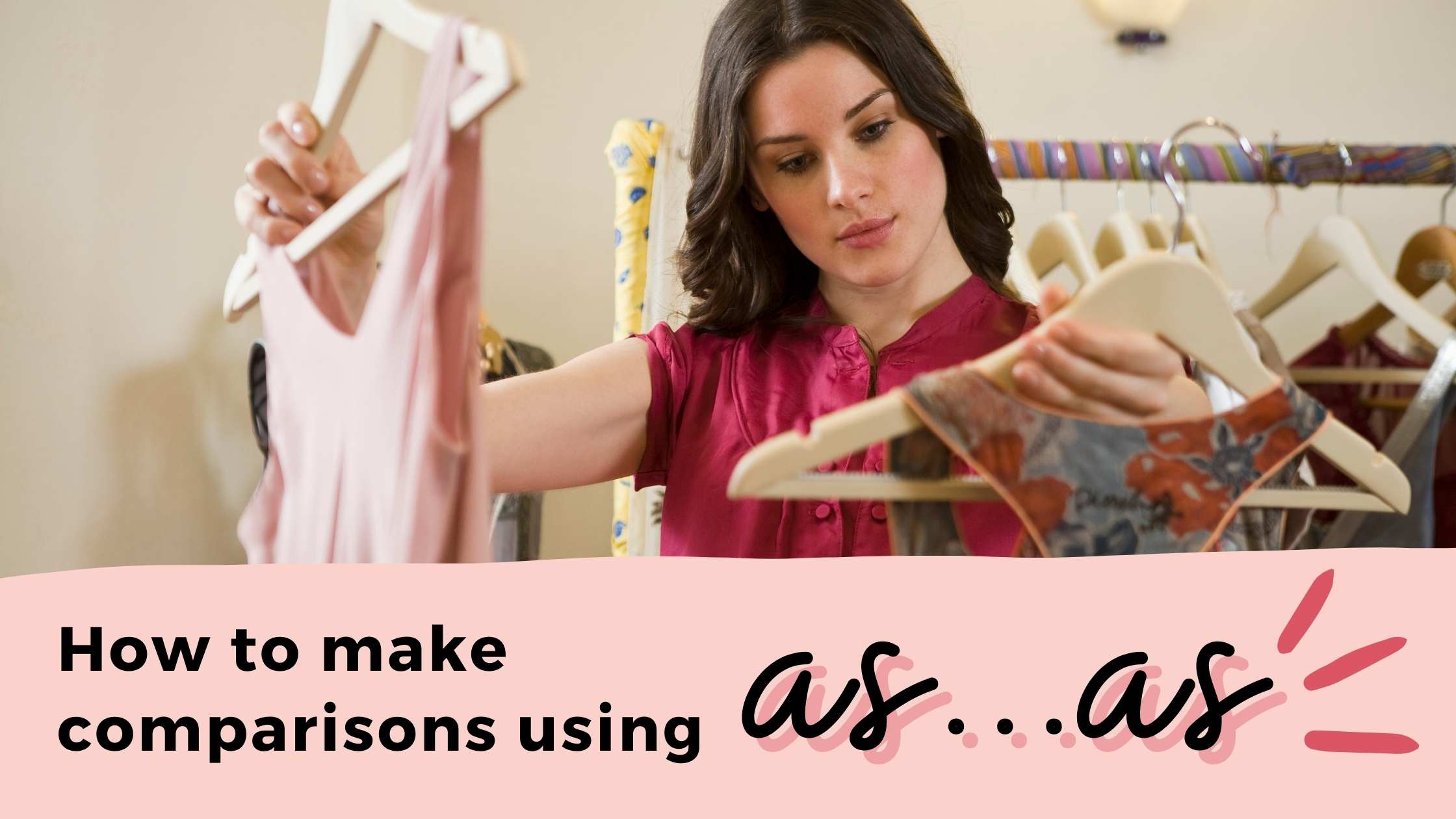How to Make Comparisons in English Using As… As and Not As… As
Adjectives have different forms in English. We use comparative adjectives to compare two things or objects and we often use the word ‘than’. Superlative adjectives are used when we compare something or someone to everything else. But what if we feel the same about two things or people? In this case, we will use as…as to show that two things are the same. If we want to say that two things are not the same, we will use not as…as. Keep reading to understand the rules for making comparisons in English with as…as, practice making the comparative with some exercises, and learn the difference between like and as.
The sentence structure of as… as
Let’s picture this: you are at the mall to buy an outfit for your best friend’s wedding. You look around the store and end up bringing three options to the dressing room. The first option is a plain yellow dress. The second one is a floral pink dress. The third option is a light green dress. You try them on and call your mom to ask for an opinion.
Imagine the conversation:
— Hi, mom!
— Hey, Valerie. How’s the shopping going?
— Well, I’m a little confused. I have tried three different dresses, but I don’t know which one I should buy.
— Ok. Tell me more.
— There’s a yellow one, a floral one, and a light green one. The yellow dress is longer than the floral one. I like it!
— Hmm, I like yellow. It looks good on you.
— Yeah, that’s true. The floral one is not as beautiful as the yellow one, but it is the cheapest. I might buy it because I don’t want to spend a lot of money.
— Oh, Valerie. Don’t worry about money. Your dad and I will pay for your dress.
— Oh, really? Thanks, mom.
— Yeah, sure. And what about the light green one? How do you like it?
— I love it. It is as beautiful as the yellow one. It is a little shorter, but I think it is the most flattering one.
— Got it. Well, send me a picture of the yellow one and the light green one then.
— Ok, mom. I will do that. Thanks for helping me.
— Sure. See you soon!
— Bye for now!
In this dialogue, we have the comparative, the superlative, and the equative (as…as, not as…as). You can review the sentence structure for the comparative here and the one for the superlative here. Now, let’s go over the structure we use when making the equative form and the non-equative form.
Equative
Subject + Verb + As + Adjective + As + Object
- It is as beautiful as the yellow one.
- Amanda looks as pretty as her older sister.
- His shoes were as expensive as his new computer.
- The new teacher is as good as the previous one.
Non-equative
Subject + Verb + Not + As + Adjective + As + Object
- The floral one is not as beautiful as the yellow one.
- They are not as shy as their friends.
- My grandpa is not as old as my grandma.
- The house is not as expensive as the apartment.
Let’s take a look at some more sentence structure examples:
- Julia got an A in her Math test. Adam also got an A in the same test. Therefore, we can say that Julia is as intelligent as Adam.
- Harry is 160 cm. Peter is 175cm. Therefore, we can say that Harry is not as tall as Peter.

The difference between like and as
We have talked a lot about how to compare people and things, but how do you compare actions?
You can use either as or like to compare actions.
Using like
Let’s take a look at some examples of comparisons using ‘like’. Remember that we are comparing action verbs, which means we are comparing how one person’s action is like another person’s action.
Peter speaks English like a native speaker.
Explanation: in this sentence, we use ‘like’ to compare Peter and a native speaker of English. Since we used the verb ‘speak’, I am comparing their abilities to communicate in a certain language. The use of the preposition ‘like’ indicates that I think they (Peter and a native speaker) communicate in a similar way.
Mary cooks like a professional chef.
Explanation: in this sentence, we use ‘like’ to compare Mary and a professional chef. Since we used the verb ‘cook’, I am comparing their abilities to prepare food. The use of the preposition ‘like’ indicates that I think they (Mary and a professional chef) can prepare food in a similar way.
Using like to compare sensory experiences
We also use ‘like’ to compare sensory experiences, using verbs such as ‘to smell’, ‘to taste’, ‘to look’, ‘to sound’, and ‘to hear’. Watch the video below for examples.
As … as: functioning as an adverb, the ‘as’ is describing the adverb (of the verb)
Amanda drives as carefully as her brother (does).
Explanation: in this sentence, we use ‘as’ to compare the way Amanda drives to the way her brother drives. This means we are comparing their actions. The adverb here is ‘carefully’.
Meredith works as quickly as her boss (does).
Explanation: in this sentence, we use ‘as’ to compare the way Meredith works to the way her boss works. We are comparing their actions. The adverb here is ‘quickly’.
Using as to describe a position
We also use ‘as’ to describe a position. Here are some examples:
- I work as a waiter.
- Beth would love to work as a teacher in the future.
- When I grow up, I want to work as a firefighter.
- As your boss, I would rather if you did what I’m telling you to do.

Comparison Grammar Exercises
The best way to practice new grammar rules is by doing exercises. We hope these making comparisons exercises help you. Good luck!
Now that you have all the info you need about making comparisons in English and that you have done some as…as grammar exercises, we hope it will be easier for you to use as…as. We also hope the difference between like and as is clear now. If you have any questions, feel free to leave a comment down below. Happy studying!

